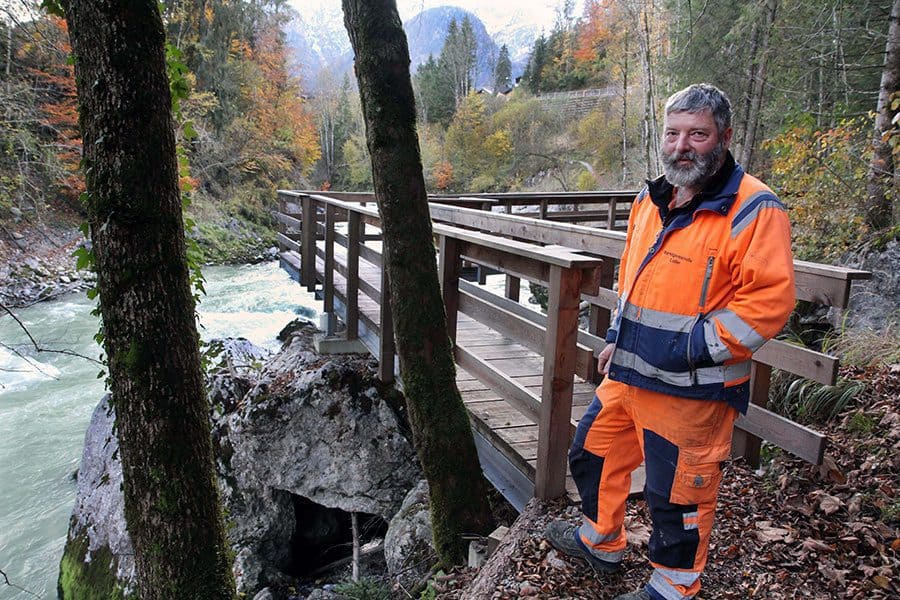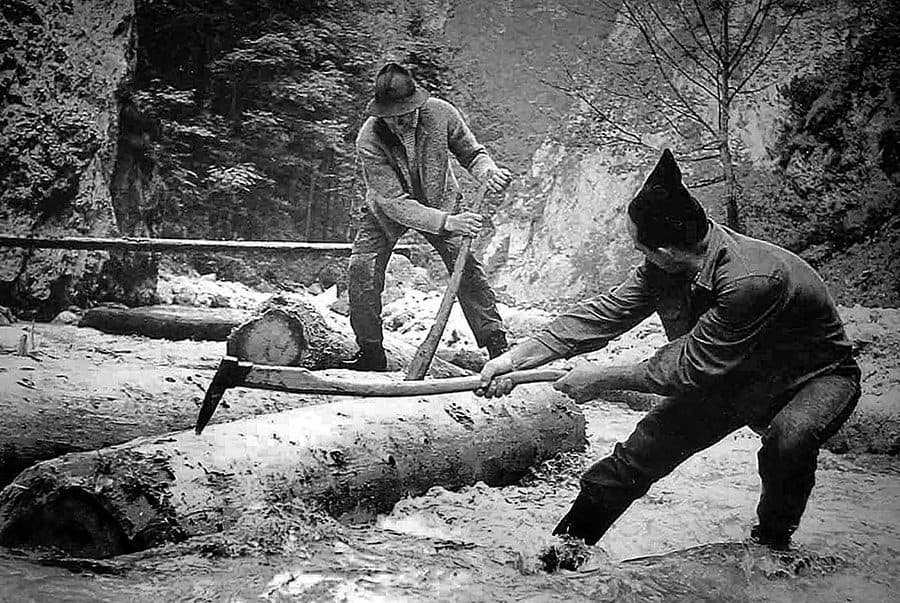The Salzburger Saalachtal has its Triftsteig back again
A tricky project
This small but beautiful trail even moved the President to visit for the opening in the 1980s. It was destroyed by the great flood in 2013 and has now been rebuilt.
It was a tricky project, carried out by council and tourist office employees over two years. “It was a huge challenge. There was nothing left, no footbridges, no passable trails”, describes project leader Hans Wimmer, thinking back to the flood of the century. Along the Saalach there is a gloomy picture. With untameable power the river makes its way to the Triftsteig and takes boulders, rocks, even entire trees with it. Swollen streams crash down from high above and unite with the river in a wild dance. There is a deafening roar and thunder, in short, a noise from hell doing justice to the name Teufelsschlucht (Devil’s Gorge). Once calm returned to this mighty natural spectacle, the old Teufelssteg (Devil’s Bridge) was history and the link to the idyllic walking path from Lofer to Scheffsnoth was cut off. A new Teufelssteg was built in 2015 but the Triftsteig which leads downstream along the Teufelsschlucht to Au had to wait. This was not just for financial reasons but also because the renovation of many sections required pure handwork. No digger could reach those parts where the slopes fall away steeply and the path leads through thick forest and no winch could be operated either.
“Gemmas an!” Or: “Yes, we can!”
In 2018 the council and the tourist office gave the go-ahead for this difficult venture. In the first section it was still possible to work with a crane and build concrete foundations. In the place where a bridge now stands, the path was literally crumbling away. After a few months the new, robust footbridge was already standing on long iron girders. The men worked forwards step by step. Where the soil had been washed away they laid subsections of larch and filled them with earth and debris. They laid a pipe down through the forest to let the gravel trickle away. The mini-digger, which had recently sunk into the mud and could only be pulled out with a great effort, had long since become obsolete. Now everything could only be done with pure muscle power – and from above. From the cycle path they unloaded the 10 metre long larch trunks, stripped them and sent them on their journey down through the thicket. This could only work with powerful restraint and skilful launching so that the trunks did not sail down into the Saalach unchecked. At the bottom they had to be turned and positioned exactly. It was always tedious but especially when it was pouring with rain. Then mud filled their shoes, explains Hans Wimmer, the building yard manager, who is delighted with the successful work today. The employees put in about 2000 man hours and used 275 tonnes of gravel and other building materials for the building site. €90,800 was spent on the renovation of the Triftsteig by external companies.
Even the President left his footprints here
The former chairman of the tourist office, Felix Dürnberger, was the first to lay out a trail along the Triftsteig. This was done in a very primitive form and had ladders as climbing aids in some places. However, the path was destroyed by the flood in 1966. Two decades later the deputy chairman of the tourist office, Arno Stainer, pressed for its restoration. He was able to motivate a lot of volunteers who, along with tourist office employees, spent many hours carting gravel to the path in wheelbarrows.
And because Arno Stainer had always wanted to inspire the world about his home town of Lofer, he wrote to the head of the Alpine Republic to ask him if he would like to open the new Triftsteig personally in 1986. The mood in the community was, “Excuse me, what? For this little path?” But one day an unexpected call came from the office of the President with his acceptance. “I thought it was a joke at first. But it was really the unmistakeable, deep voice of Rudolf Kirchschläger“, says Arno Stainer, who incidentally laid out the very first “themed trail” in Austria along the Triftsteig, with information boards about the history of the wood drift on the Saalach.
A reminder of the wood drift on the Saalach
These days the Teufelsschlucht with its powerful water vortices, huge stones and rocks attracts international kayakers and canoeists year after year. What is a playground for them used to be a fight for wood for the former wood drifters. For centuries this was transported, drifted, on the Saalach to Bad Reichenhall. There it was needed in huge quantities to heat the saltwork brewhouses. In these salt steamed, the “white gold” of the time. Drifting began when the snow melted and in heavy rain. At the same time the dammed up tributaries of the river were activated. They burst out as soon as the dam gates were opened. The firewood which had been thrown in thundered down to the saltworks in the valley. Along the Saalach the men had to free any backed up wood. Some were pulled into the waters and drowned. Drifting on the Saalach ended in 1911 with the construction of the Saalach power plant and the reservoir in Bad Reichenhall. After that the old drift paths along the Saalach fell into disrepair. However, beautiful sections were included in today’s Triftsteig.



